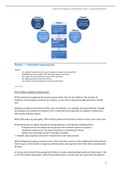Samenvatting
Samenvatting literatuur Environment & Society (2021/2022)
Alle verplichte literatuur voor E&S samengevat. Artikelen: Diaz et al Pretty et al Giddens Visseren-Hamakers Robbins and Moore Steffe, Grinevald, Grutzen, Mcneill Baskin Biermann Adger and Jordan Benford and Snow Hannigan Clapp and Dauvergne Tomlinson Cronon Gould and Schnaiberg Mo...
[Meer zien]






